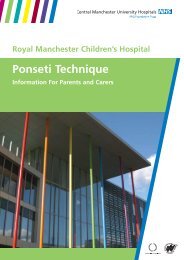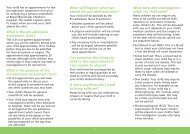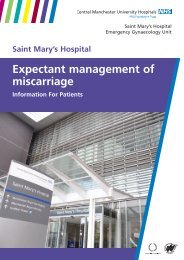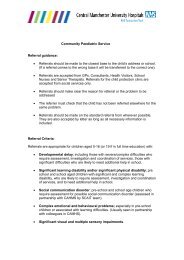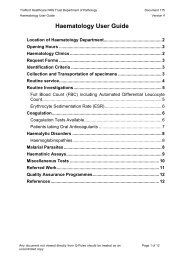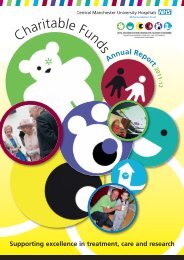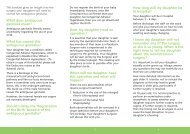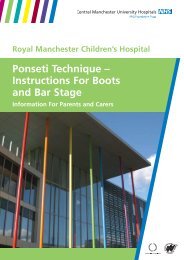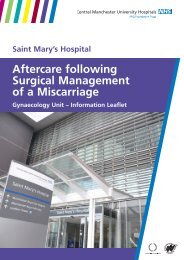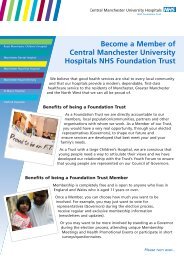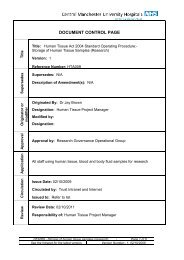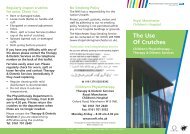Scoliosis
Scoliosis
Scoliosis
You also want an ePaper? Increase the reach of your titles
YUMPU automatically turns print PDFs into web optimized ePapers that Google loves.
Royal Manchester Children’s Hospital<br />
<strong>Scoliosis</strong><br />
Information For Parents and Carers
What is scoliosis?<br />
<strong>Scoliosis</strong> is a lateral (sideways) curvature of the spine. It can be<br />
due to abnormalities in the legs but is most commonly due to<br />
a problem in the spine. It usually develops during early<br />
adolescence. In most cases the curve is slight but in severe<br />
cases the spine can become ‘C’ or ‘S’ shaped.<br />
A normal spine appears curved when viewed from the side and<br />
straight when viewed from behind. In scoliosis, the opposite is<br />
true, that is the spine appears straight when viewed from the<br />
side yet curved when viewed from behind.<br />
Facts about scoliosis<br />
• 1 in 20 people has scoliosis generally in a very mild form.<br />
• Of these 1 in 20, five percent, will have a more severe<br />
spinal curvature.<br />
• <strong>Scoliosis</strong> is generally not painful in young people but can<br />
become painful in adults.<br />
• <strong>Scoliosis</strong> is treated most successfully when the patient is<br />
younger. The body can respond better to treatment while it<br />
is still growing.<br />
• <strong>Scoliosis</strong> may increase during growth periods. Larger curves<br />
may continue to progress during adult life.<br />
Signs of scoliosis<br />
• One shoulder may be higher than the other.<br />
• One shoulder blade may be higher and more prominent.<br />
• One hip may be more prominent than the other.<br />
• Clothes may not ‘hang right’ – it is often difficult to get a<br />
hem to hang level or trousers to appear the same length.<br />
• Girls may complain that one breast appears less prominent<br />
than the other.<br />
3
What causes scoliosis?<br />
Eighty percent of scoliosis is of unknown cause (idiopathic).<br />
Much research is being done into this field including work at<br />
the Royal Manchester Children’s Hospital. In most of these cases<br />
the condition develops in girls between 10 –15 years old and is<br />
more common in the relatives of those affected.<br />
Other cases are congenital (caused by abnormal development<br />
of the bones in the spine) and some are due to problems with<br />
nerves or muscles (such as cerebral palsy or muscular dystrophy).<br />
How is scoliosis detected?<br />
<strong>Scoliosis</strong> can be seen by a trained observer looking at a patient’s<br />
back. When a patient bends forward one side of the chest or<br />
loin may appear more prominent if scoliosis is present.<br />
Some education authorities screen all teenagers for scoliosis.<br />
If the school doctor has any doubts then an appointment is<br />
usually arranged at the scoliosis clinic for X-rays to be taken.<br />
Monitoring and progression of the curve<br />
Although some new photographic methods are now becoming<br />
available, X-rays are still the most reliable way of detecting any<br />
worsening in the degree of scoliosis.<br />
At the time of diagnosis there is no accurate way to predict<br />
which curves will worsen. Some smaller curves do not get<br />
worse. Many curves remain stable for years but suddenly get<br />
worse during the adolescent growth spurt. The child’s potential<br />
for growth is therefore one of the most important factors in<br />
predicting curve progression. In general, patients who have a<br />
lot of growth to come have a higher risk of curve progression.<br />
Growth potential, and therefore potential for curve<br />
progression, can be evaluated by age at diagnosis, menstrual<br />
history and radiological signs of bone maturity. Overall, females<br />
with scoliosis have a greater risk of curve progression.<br />
4
Treatment<br />
<strong>Scoliosis</strong> is treated to prevent curve progression and also<br />
to preserve good appearance. There are three main types<br />
of treatment/care:<br />
• Observation<br />
• Bracing and casting<br />
• Surgery<br />
Observation<br />
Patients with a recently diagnosed mild curve are observed<br />
for a period of time to determine if the curve will progress.<br />
Since most curves do not become severe, observation is often<br />
all that is required. This enables the Surgeon to plan any active<br />
treatment that may be necessary.<br />
The most accurate method of observation is to perform a<br />
standing X-ray. Each X-ray is compared with the previous one<br />
to determine the amount of curve progression. Generally those<br />
with mild curves are seen in clinic every six months but those<br />
with larger curves will be seen every three to four months,<br />
especially if the child is growing rapidly.<br />
5
Bracing<br />
Bracing maybe used when the child is growing rapidly and the<br />
curve is between 20 and 30 degrees. The purpose of bracing is<br />
to control the curve and slow down further progression.<br />
The brace most commonly prescribed in the clinic at Royal<br />
Manchester Children’s Hospital is the Boston under arm brace.<br />
Research has shown that this needs to be worn for 16 hours<br />
per day if it is to be effective.<br />
Brace treatment is not always effective but its effect can<br />
sometimes be predicted by looking at X-rays taken in the<br />
brace shortly after it has been fitted.<br />
Surgery<br />
Surgery is generally performed when it is thought that the<br />
spinal curvature at skeletal maturity will be greater than 50<br />
degrees. Surgery consists of straightening the spine and<br />
performing a spinal fusion operation to hold it straight.<br />
The type of surgery depends on the curve type.<br />
Before surgery a magnetic resonance (MRI) scan will be<br />
requested to examine the nerves in the spine.<br />
6
Tips for parents<br />
• Don’t panic! Many advances in surgical and other kinds<br />
of treatment have been made in this field. Doctors who<br />
treat scoliosis are familiar with it and have repeatedly<br />
demonstrated high levels of success in treating scoliosis.<br />
• Ask questions. You should discuss your child’s problem with<br />
your Doctor. Write down questions so they are not<br />
forgotten at your child’s next visit.<br />
• If your child needs to wear a brace establish a daily routine<br />
for its use. This makes coping with the brace a little easier.<br />
• Make a conscious effort to treat your child as normally<br />
as possible.<br />
• Speak to other parents and allow your child to speak to<br />
other children with a similar condition. Your child will need<br />
support throughout treatment.<br />
For further information please contact:<br />
<strong>Scoliosis</strong> Nurse Specialist<br />
Direct Line: 0161 701 0634<br />
Monday – Friday 8.00 am - 4.00 pm<br />
Spinal Office<br />
Direct Line: 0161 701 2170/2754<br />
Monday – Friday 9.00 am - 5.00 pm<br />
Further resources<br />
<strong>Scoliosis</strong> Association (SAUK)<br />
2 Ivebury Court<br />
323-327 Latimer Road<br />
London W10 6RA<br />
Tel: 0208 964 1166<br />
www.sauk.org.uk<br />
7
No Smoking Policy<br />
The NHS has a responsibility for the nation’s health.<br />
Protect yourself, patients, visitors and staff by adhering to our<br />
no smoking policy. Smoking is not permitted within any of our<br />
hospital buildings or grounds.<br />
The Manchester Stop Smoking Service can be contacted on<br />
Tel: 0161 205 5998 (www.stopsmokingmanchester.co.uk).<br />
Translation and Interpretation Service<br />
Do you have difficulty speaking or understanding English?<br />
☎ 0161 276 6202/6342<br />
Spinal Deformities Centre<br />
Royal Manchester Children’s Hospital<br />
Oxford Road, Manchester M13 9WL<br />
Tel: 0161 701 0634 Monday – Friday 8.00 am - 4.00 pm<br />
For urgent queries contact Ward 78 on 0161 701 7800<br />
www.cmft.nhs.uk<br />
TIG 20/10 Produced January 2004 Updated January 2010 Review January 2012 (SF Taylor CM2084)






